It is rare to find actual images of Aztec (Mexica) people today, as the remaining population of Nahuatl-speaking Aztecs nowadays would rather speak Spanish to avoid discrimination. Thus, most of the physical features described here are from codices, paintings, and existing images.
Like other Native Americans, the Aztecs have brown to light brown skin color with light facial hair. The most prominent facial feature is their nose, described as hooked or aquiline. Their hair is straight, coarse, and black. The Aztecs have a strong class system; thus, their manner of dressing, the sandals on their feet, access to more nutritious food, and even the style of their hair vary.
According to the Spanish conquistadors, the Aztecs were tall and with good body types. The Spanish described them as dark-skinned like leopards, but they had good gestures and manners. In addition, they found the Aztecs tireless, robust, and skillful.
Facial Features
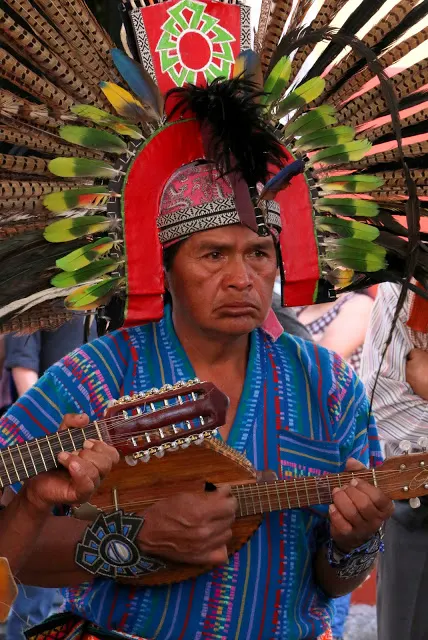
The facial features of the Aztecs are similar to the Native Americans of today. With most of the records destroyed, many experts rely on sculptures, paintings, and codices to determine what the Aztecs looked like. From all accounts, they have black hair, brown skin, a broad face, almond-shaped black or brown eyes with epicanthic fold at the outer corners, and a prominent nose. However, the Aztecs practiced body modification or body alteration.
They had several ritual practices like grabbing children by the neck to make them grow taller. Upper-class citizens bind their infants’ heads with padded boards or bands to create an elongated head. Some filed their tooth while others bored holes and filled them with precious stones. Young males and females had ear piercings, with a maguey spine or bone awl until the holes were big enough to insert ear spools. Young boys destined to enter the military had lip piercings.
Facial Hair
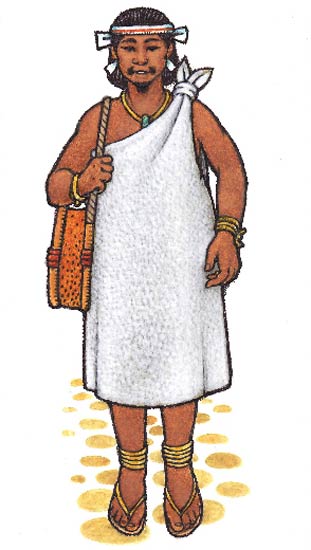
While the Aztecs had good hair growth, they barely had facial hair. It was a good thing because the men considered facial hair unpleasant. However, they have to thank their genetics for that. They had meager beards, and only needed to pluck out wispy facial hair growth. After a while, plucking prevented hair growth, so their faces remained free from hair.
Aztec mothers applied hot cloth on the faces of their young sons to stifle hair follicles and prevent the whiskers from growing. Aztec men did not have significant hair growth on the sides of their faces and their cheeks. They did have occasional chin hairs and a wispy mustache. Cortes described Moctezuma Xocoyotzin (Moctezuma II) as having short beard under the lip piercing. For the Aztecs, only distinguished or older adults could wear wispy and thin beards as a sign of reverence and old age.
Hair Styles
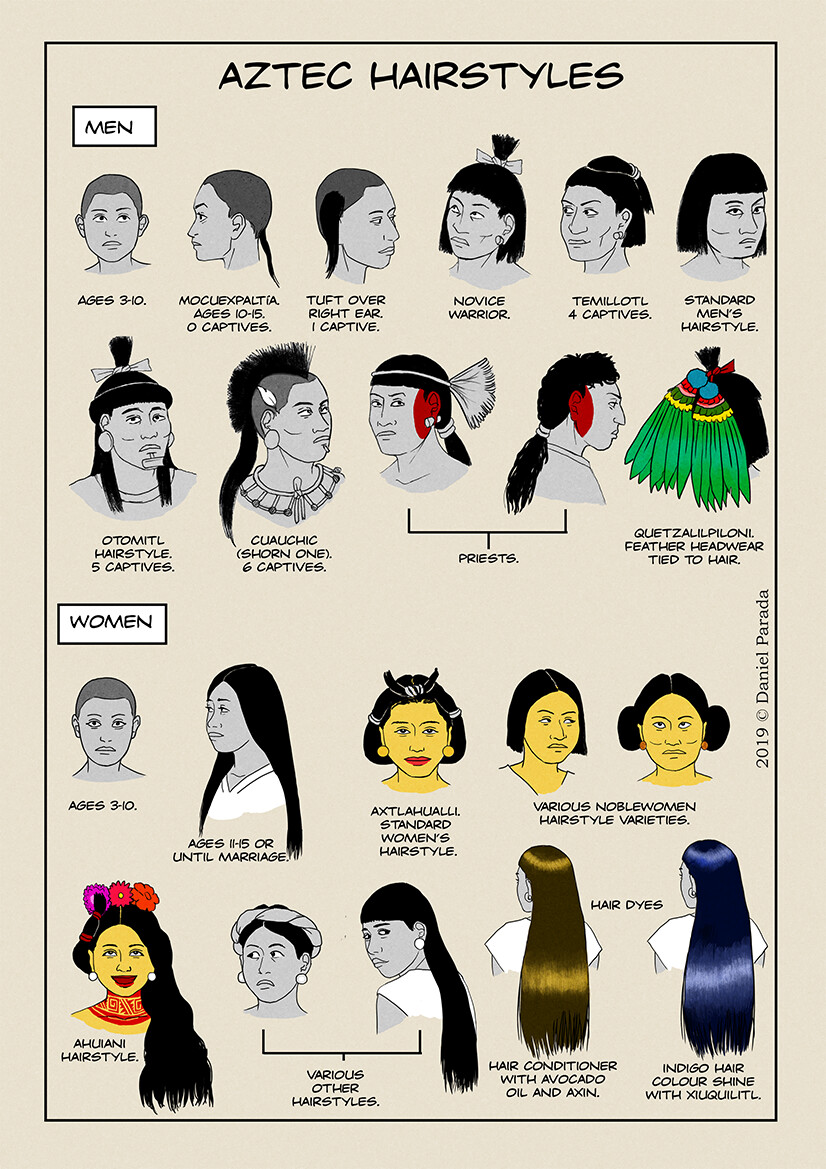
The Aztecs had straight, coarse, and black hair based on various codices. They wore different hairstyles according to their ranks and professions. The commoners wore their hair with fringe over their foreheads, with the back part allowed to grow to shoulder length. Young girls were allowed to grow their hair. Married women had hair down to their napes but parted their hair in front, twisting them into two horn-like top knots near their foreheads.
Young boys, until the age of ten, had shaved heads. Afterward, they grew a patch of hair at the back of their heads, which they could only cut after capturing an enemy during battle. A Quachic warrior had a shaved head with a stiff ridge of hair growing at the center of his head. Priests let their hair grow until they die. On the other hand, nobles wore different hairstyles with various ornaments.
Nose Shape

The Aztecs had hooked noses based on records, paintings, sculptures, and masks. A hooked (hawk) nose, or an aquiline nose, is called such because it resembles the curved beak of a hawk and other birds of prey. An aquiline nose features a prominent bridge and a dramatic curved shape. It gives a person a firm profile. For example, in most of the paintings of Moctezuma II, the painter/s clearly showed the fine shape of his nose, showing its hooked shape. It is the same with the jadeite mask.
The aquiline nose is a distinctive feature of many Native American tribes. It is a vital feature, depicting a noble warrior type.
Height
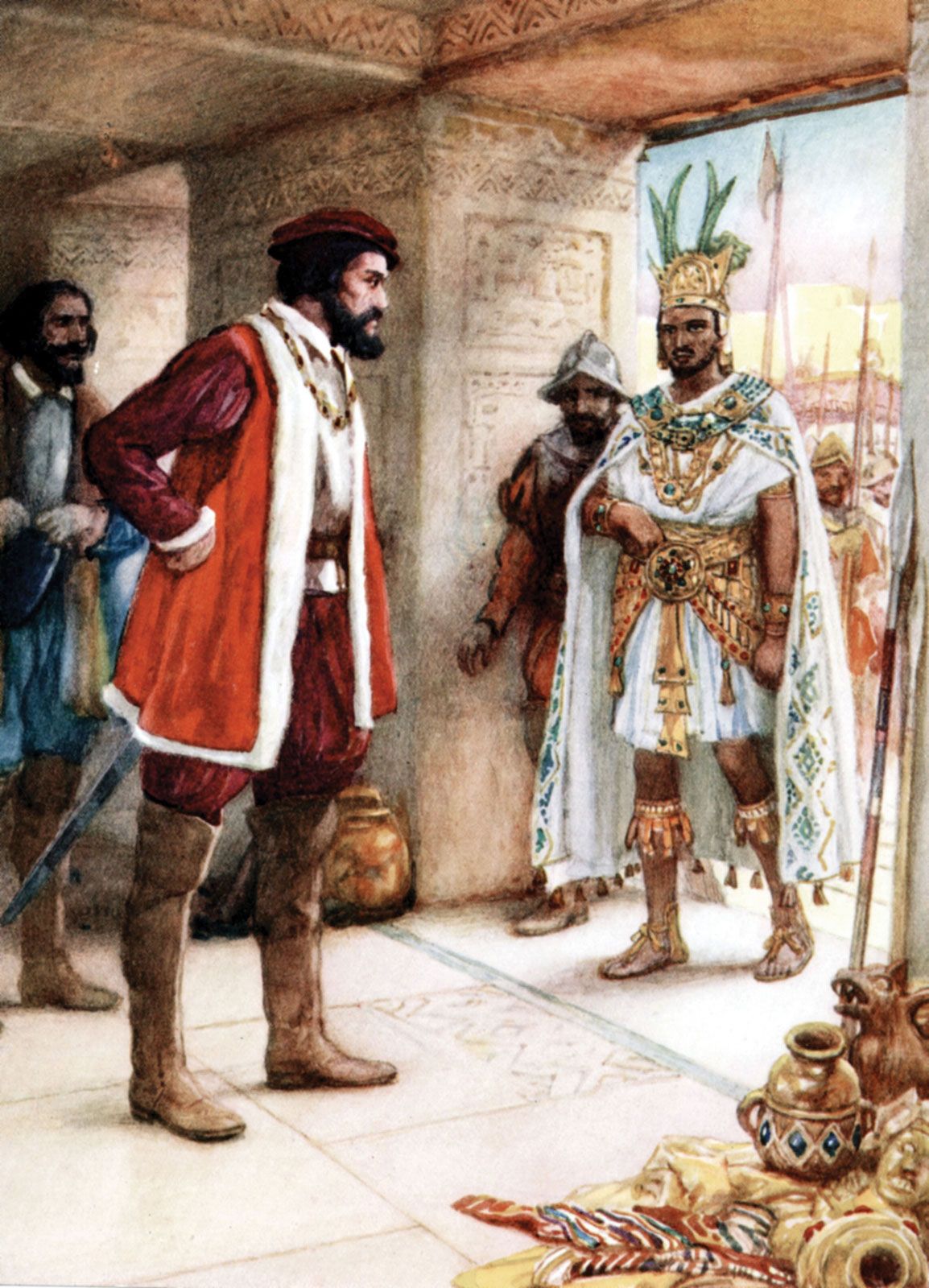
There are conflicting theories about the average height of the Aztecs. Some people say they were stocky and short. However, Spanish invaders said they were not short people. According to excavated remains, the males were about five feet six inches tall, while the females’ average height was around four feet and eight inches. In the 1600s, the average height of men is between five feet five inches and five feet eight inches. Thus, some historians assumed that Aztec males were of average height. However, commoners were typically around five feet tall. Further, remains of people found in nobles’ houses and palaces were taller by two inches, indicating that they consumed food high in protein.
Considering that today’s global average height is five foot two for females and five foot seven for males, the Aztecs were not short. Today’s generation of Mexicans is even shorter than average.
Weight

There is nearly no information about the average weight of Aztec males and females. However, if you consider their diet and lifestyle, it is easy to conclude that they were lean and of average weight. They ate only twice a day, and their diet consisted of grains, fruits, and vegetables. They walked everywhere and carried items using a carrier frame with a strap across their forehead. Most of them were farmers, enslaved people, and warriors. Only a small percentage of the population belonged to the nobility.
If the males were about five feet and six inches tall, their average weight would be between 128 and 156 pounds. However, considering that the females were said to be about four feet eight inches tall, their weight would be around 72 to 88 pounds.
Typical Body
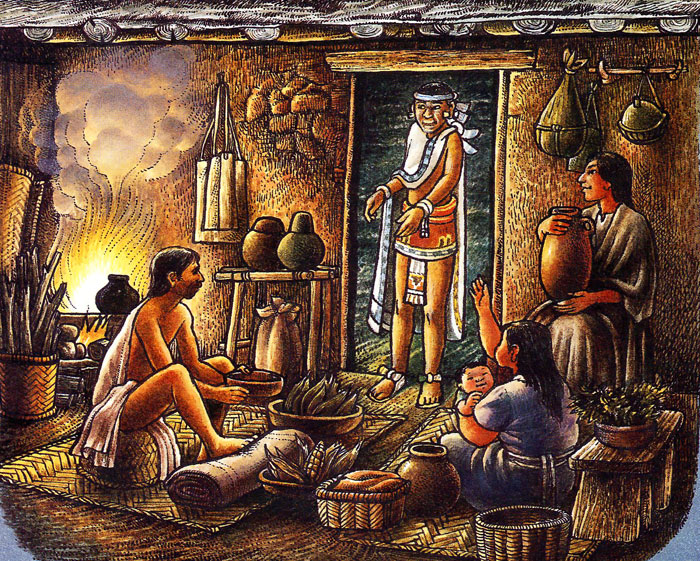
Gauging from drawings and paintings, Aztecs were generally lean and healthy. For one thing, their native doctors have empirical knowledge of herbs and medicine. They lived healthy, simple, and clean lives. They exercised well and followed a good diet. They walked everywhere and used a frame to carry loads. They had access to clean water because they knew how to build aqueducts to bring natural spring water from the hills to their capital city.
Their diet was varied and healthy. Aztecs ate low cholesterol, high-fiber food. They mostly ate maize, beans, and squash flavored with chilies, tomatoes, onions, and various herbs. In addition, they had avocados, chia seeds, grain amaranth, spirulina, and wild mushrooms. They got their protein from the acocil, worms, grasshoppers, larvae, and ants. Commoners rarely ate meat. The wealthy people have a more varied menu, as they have access to more vegetables and meat from birds, fowl, frogs, turtles, crabs, lobsters, and wild game.
Makeup Habits
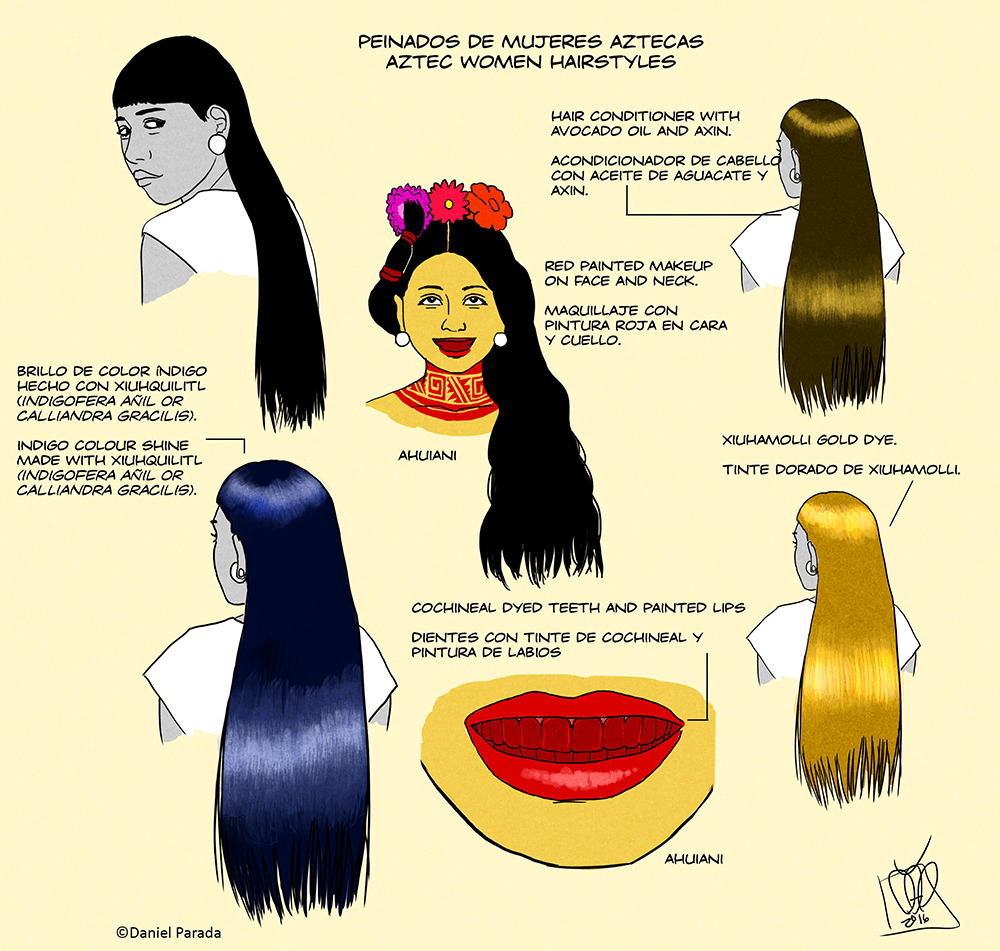
Aztec women did not generally use makeup or decorative body paint. However, an expert in pre-Columbian civilizations, Manuel Aguilar-Moreno, stated that Aztec women applied tecozahuitl, a yellow clay, and yellow-tinted body makeup called axin over their face and limbs. The application of this yellow paint represented a woman’s maturity, as the color is similar to ripened grains and fruits. Some women who were temple workers dyed their long black hair with a red hue. They applied black color to their teeth and etched complex designs on their faces, legs, and arms. On the other hand, priests painted their bodies black before covering the paint with ash, symbolizing darkness, magic arts, and the wisdom of sorcerers.
Aztec women did not stain their lips as only women of ill repute used rouge and lip color. These courtesans colored their teeth red using a dye extracted from cochineal, a type of scale insect.
Skin Tone
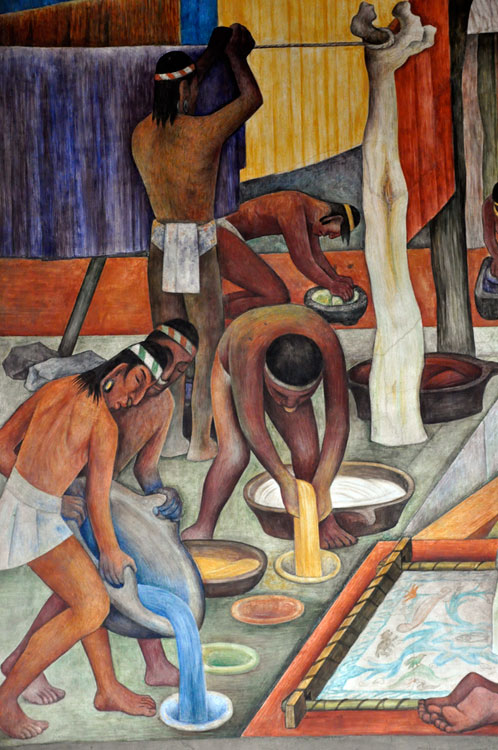
The Aztecs, like most of the pre-Columbian peoples before them, had skin color ranging from light brown to dark brown. The skin color is similar to other Native Americans. They appeared to have a darker skin tone compared to the light-skinned conquistadors. However, according to historians and experts, skin color depends on the tribe and the person. Some of them say that Aztecs had deeply tanned olive skin, which some call bronze.
Dressing
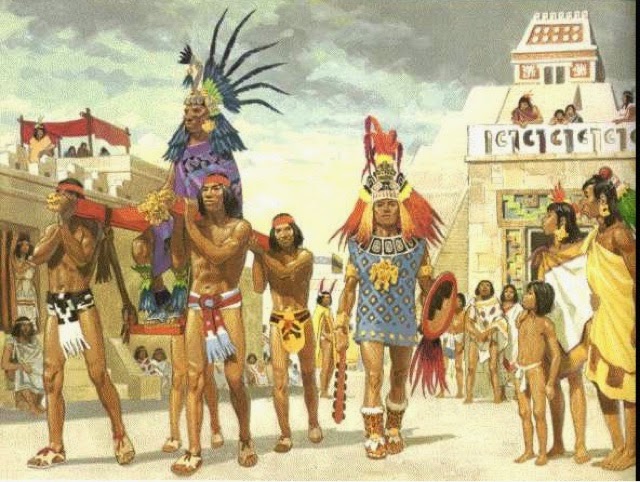
The Aztec society was divided into different classes, and each class wore a different type of clothing. They reserved ornate clothing for royalty, nobility, and high priests. Jewelry was a status symbol.
The basic clothing for men was the loincloth (maxtlatl). Over it, they wore a cloak or cape (tilmahtli/tilma) tied over one shoulder. Aztec women wore a short blouse (huīpīlli) with a long skirt (cuēitl) and a sash tied around their waists. Young children wore nothing until age four.
Warriors wore a loincloth and a special armor made of thick layers of cotton, while the high ranking ones wore suits that covered their torso, legs, and arms,
According to their law, only the nobles could wear cotton clothes, while the commoners wore clothes made from maguey fibers. Likewise, only the nobles could wear leather sandals. The rest of the population had to go barefoot.